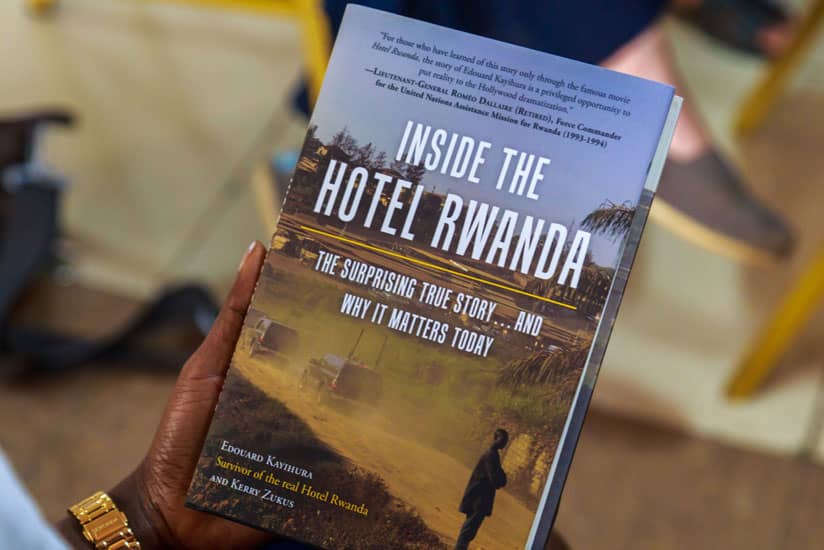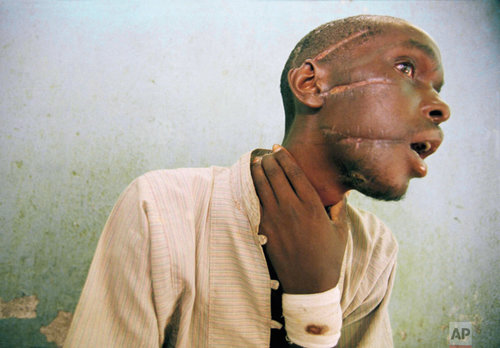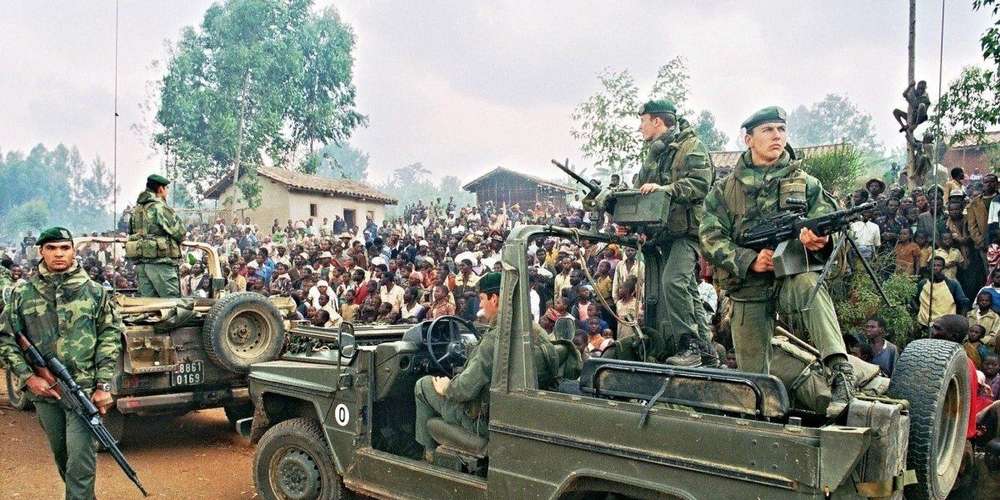Regional
Surviving 1994 Genocide at Hôtel des Mille Collines

Edouard Kayihura, one of the survivors from the hotel, years ago, co-authored a book as part of his contribution in exposing the lie that Paul Rusesabagina saved the Tutsi at the hotel
Next week, Rwandans will be marking the 27th commemoration of the Genocide against the Tutsi in Rwanda. For survivors, the sad memories are as fresh as they were in 1994. When you speak to those who survived from Hôtel des Mille Collines, it is as if the ordeal was lived yesterday.
It is probably
worse for them because, every day, they see the gruesome ordeal being distorted
just to benefit some individuals and organizations. This is a trend they need
to end so that they can grieve peacefully.
As soon as the
killing machinery was set rolling in April 1994, hundreds of thousands of Tutsi
left their homes to seek refuge in different places where they felt they would
live to see another day.
Many believed
they would be safe in churches, others in the bush, or in a neighbour’s
bedroom. Others in Kigali sought refuge at the famous Hôtel des Mille Collines
which was at the time protected by UN peacekeepers deployed in Rwanda.
The story of the
hotel and its manager at that time, Paul Rusesabagina, was later used as the
basis of Terence George's fictional film "Hotel Rwanda" in 2004. The
Hollywood film inaccurately portrayed Rusesabagina as a hero.
Edouard Kayihura,
one of the survivors from the hotel, years ago, co-authored a book as part of
his contribution in exposing the lie that Rusesabagina saved the Tutsi at the
hotel. The book, “Inside the Hotel Rwanda: The Surprising True Story…and Why It
Matters Today,” details the story of what really happened.
The commemoration
period is a time to remember and recount the stories for the current and future
generations to know the truth and honor the more than one million victims the
Genocide.
Today, people
around the world especially want to hear from the survivors of “Hotel Rwanda”
about what informed their choice for a hiding place, and how they endured until
they were rescued, and so much more.
Those who
survived from the hotel believe that, 27 years later, the true story of what
actually happened inside the hotel must be told. They are saddened by
Hollywood's manipulation of this story for what they see as selfish interests.
According to
survivors, the prerogative of the creative industry must be that of telling the
truth of what occurred throughout the Genocide as a social responsibility. They
feel the world owes them this at the very minimum, and rightly so.
What really happened inside the hotel?
In 1994, Hôtel
des Mille Collines was a property of Sabena, a Belgian company, and had a
Belgian national as its manager. When the massacres started in Kigali, the Belgian
managers were evacuated to their country.
Before their
departure, the Tutsi who had taken refuge at the hotel were accommodated as
well as given food and water - all free of charge.
When the Belgian
managers left, the circumstances suddenly changed from very bad to worse. Paul Rusesabagina who worked at the nearby
Hotel des Diplomates appointed himself the hotel manager.
In 2011, Bernard
Makuza; one of the survivors from the hotel said “Rusesabagina came to the
hotel looking for fuel with the aim of fleeing to Gitarama where the government
had shifted their Headquarters.”
As he arrived at
the hotel looking for gas, he seized the keys of the hotel from a young
receptionist and quickly calculated how he was going to take advantage of the
vacuum left by the Belgians to enrich himself.
Rusesabagina
started to demand money from the refugees. He compelled those without cash to
sign cheques and promissory notes as he threatened to show those without money
the door.
Some of the
cheques given to him by the refugees were later cashed in Gitarama (now
Muhanga), a town approximately 45 kilometres by road southwest of Kigali, where
banks were still operating. Rusesabagina’s motivation - money and greed - will
take us through what transpired inside the walls of the infamous “Hotel Rwanda”
and how the hundreds who sought refuge there survived the bloodbath outside.
Why hide at Hôtel des Mille Collines?
The Great Lakes
Eye talked to survivors from Hôtel des Mille Collines and they all confirmed
that the belief that foreigners, mainly Europeans, who were at the hotel would
protect them was their main reason for choosing the hotel as their hiding
place.
At first, the
people who went to the hotel were the rich who could afford to pay. Many Hutu
families passed through the hotel before fleeing to Gitarama and other parts of
the Southern Province, because rumor had it that the Rwandan Patriotic Army
(RPA) rebels had taken the east of the country and were quickly advancing to
Kigali. This, according to the survivors, made the hotel a less likely target.
Although he
always chased refugees out for lack of payment, according to survivors,
Rusesabagina's attempts never often succeeded. Those he chased out would dodge
him around the hotel and stay; like in a cat and mouse game.
Those expelled
from their rooms by Rusesabagina would be smuggled into other rooms by friends.
They stayed in crowded rooms and sometimes a single room contained more than 20
people. Rusesabagina did not have the cooperation of the hotel staff in his
endeavors. Hotel staff saw him as an impostor who had assumed management of a
hotel where he didn’t work.
Other refugees
gathered in a conference hall. The unlucky ones who met him at the entrance of
the hotel were turned away if they did not have money. The unlucky ones were
caught by Interahamwe militia who were roaming around the hotel manning a
roadblock right at the hotel’s entrance.
Purely a business relationship
Around the end of
April 1994, Rusesabagina received orders from the owners of the hotel to allow
in, and treat fairly, without asking all
refugees at the hotel for money.
But he ignored the orders and kept on squeezing every penny he could from the frightened refugees. Rusesabagina ran a lucrative business sending Interahamwe militia to buy food, liquor, beer and other luxury items which he sold to some refugees who had money.
His business was
often supplied by military officers and Interahamwe militia leaders who looted
from the neighborhood. Perhaps that is what Rusesabagina described as bribing
army officers to spare the refugees, survivors said.
Majority of
refugees, already cash-starved, depended on the water from the hotel’s swimming
pool before it was completely drained. Distressed by their deplorable living
conditions, the refugees used the hotel phones to alert international
organisations about their situation, and asked for help.
As soon as this
was discovered, telephone lines were disconnected and only the phone in
Rusesabagina’s office was operational. He then charged whoever wanted to make a
phone call.
How they were finally brought to safety
When the advancing RPA took control of Kanombe military barracks, it was a big blow to the genocidal government and its armed forces. More than 800 government soldiers, and their families, are said to have surrendered to the UN peacekeeping mission's Force Commander, Gen. Romeo Dallaire, who handed them over to the Red Cross. These soldiers ended up in the RPA controlled zone as prisoners of war.
They were later
exchanged with all the Tutsi hostages inside Hôtel des Mille Collines. This
exchange emanated from a meeting at Hotel des Diplomates where UN peacekeepers,
the militia and the government decided that refugees in Hôtel des Mille
Collines would be exchanged for government soldiers held inside the RPA zone.
That is how the
Tutsi inside the hotel were rescued. It was not by Rusesabagina as depicted in
his self-proclaimed Hollywood fiction heroism tale.It was the RPA that pulled
the exchange that eventually saved these people's lives. Honouring the memories of the survivors from
Hôtel des Mille Collines is doing justice to victims of the Genocide and
contributing to their healing process.




